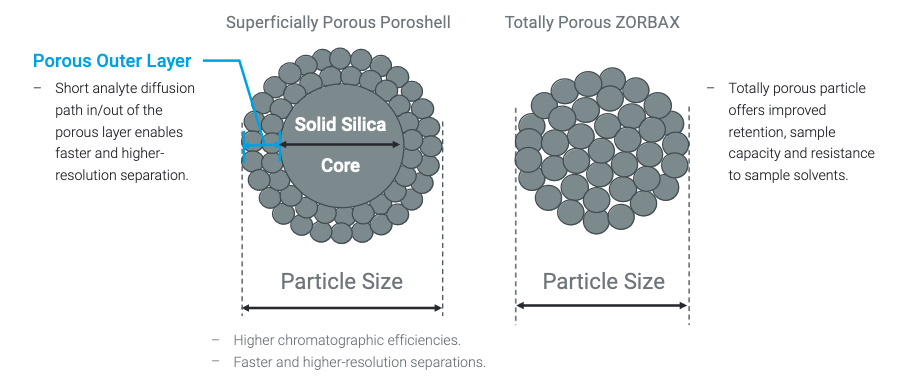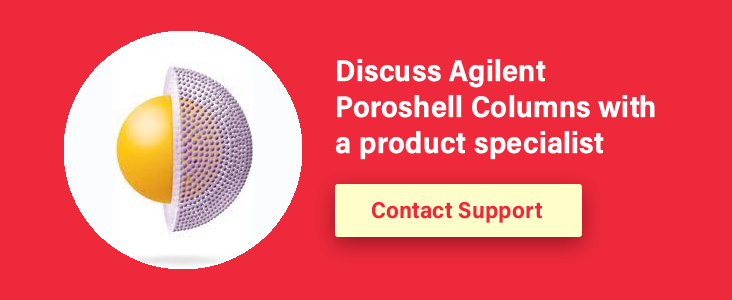Posted by Chrom Tech on 16th Oct 2025
Revolutionizing Your Chromatography | The Power of Poroshell and more
Are you dealing with increasing backpressure from your HPLC column or wishing for UHPLC-level performance without upgrading your entire system? Choosing the right tools is critical—but navigating the wide range of options can feel overwhelming. In this article, you’ll learn how to fine-tune your chromatography setup, improve efficiency, and achieve sharper, faster results using Agilent Poroshell technology and other key strategies.
Superficially Porous Particles: The Core of Modern Column Design
One of the most impactful ways to improve chromatographic performance is by upgrading your column. Agilent’s Poroshell columns use superficially porous particles (SPP), a design that has transformed how analysts balance speed, resolution, and backpressure. While fully porous particles are still common, the benefits of SPP technology are significant.
Superficially porous particles have a solid core surrounded by a thin porous shell. This structure shortens the diffusion path for analytes, resulting in improved efficiency, resolution, and peak shape. For laboratories aiming to enhance method performance without overhauling their instrumentation, SPP columns are an ideal choice.

Reducing Backpressure: The Advantages of Agilent Poroshell
One of the defining advantages of SPP columns like Agilent Poroshell is reduced backpressure. Because the mobile phase doesn’t need to flow through fully porous particles, the system experiences less resistance, enabling faster flow rates without exceeding pressure limits. This allows you to achieve UHPLC-level separations on standard HPLC systems.
Another key design benefit is Poroshell’s narrow particle size distribution. This uniformity allows for a more consistent packed bed and supports a 2 µm frit—compared to the smaller frits (0.2–0.5 µm) used in many sub-2 µm fully porous columns. Smaller frits are more prone to clogging, which can shorten column life and increase backpressure. The takeaway? Agilent Poroshell columns deliver robust, high-resolution performance with extended column lifetime and lower maintenance requirements.
The Importance of Proper HPLC Connections
Even with the best column available, poor system connections can undermine performance. Common problems include leaks, dead volume, and distorted peak shapes. Proper installation and maintenance of fittings are essential for optimal chromatography results.
Fortunately, Chrom Tech offers several solutions for leak-free, low-dead-volume connections. You can explore one popular option in our post here. Additionally, remember that tubing selection also impacts system pressure and signal quality. If you’re unsure which tubing or fittings to use, our product specialists are available to help—just fill out the form at the link below.
Often Overlooked: The Role of Sample Preparation
Even the most advanced column can’t compensate for poor sample quality. Effective sample preparation ensures consistent and reliable results. Depending on your workflow, this may include techniques like filtration, dilution, or solid phase extraction (SPE). Each approach has its benefits, and choosing the right one depends on your matrix and analytical goals.
Chrom Tech offers a range of sample prep resources and products to help you find the best fit for your workflow. Whether you’re refining existing methods or building new ones, our team can recommend practical solutions tailored to your application.
Elevate Your Chromatography with Chrom Tech
Chromatography continues to evolve, with technologies like Agilent Poroshell redefining what’s possible in efficiency and performance. If you’re frustrated with inconsistent results, excessive backpressure, or slow separations, Chrom Tech is here to help. Our experienced chromatography specialists can help you identify the best solutions for your system—so you can achieve faster, more reproducible results while saving time and resources.
With cutting-edge technologies and expert guidance, Chrom Tech empowers your lab to reach the next level of performance.
Frequently Asked Questions
What are the benefits of superficially porous particles in chromatography?
Superficially porous particles (SPP) offer shorter diffusion paths, which enhance efficiency and resolution compared to fully porous particles. They also generate lower backpressure, allowing faster analysis without overloading HPLC systems.
How do Agilent Poroshell columns reduce backpressure?
Agilent Poroshell columns feature a solid-core design that prevents the mobile phase from fully penetrating each particle. This reduces flow resistance, resulting in lower backpressure and faster separations while maintaining high resolution.
Why are proper HPLC connections important?
Incorrect or loose fittings can cause leaks, dead volume, and peak distortions. Using high-quality fittings and properly installed tubing ensures stable pressures, improved signal quality, and reliable chromatographic performance.


